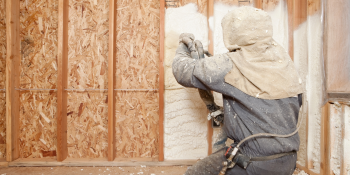Q&A Forums
open cell as an ib? Post New Topic | Post Reply
| Author | Comments |
|---|---|
|
philip mullins
Posted: Feb 08, 2011 12:46 PM
|
open cell as an ib?
hey guys, looking at an attic job i bid a couple years ago. didnt get it but the client is calling me for guidance. the guy that sprayed it was cheaper than me and since the dude is a preacher the client felt like he could trust him. problem is the foamer never discussed the depth of the foam. just gave him a price to spray it, depth unspecified. so he got 1 inch of closed cell foam sprayed under the decking, ridge and gable vents left open, as well as the soffit vents. and of course, no ib.the customer has recently became aware of the ib debate and is concerned. he also would like a more effective insulation system. im considering proposing to close the vents, ridge and gable, with closed cell and adding 5 inches of open cell to the entire attic over the cc. think this will help the guy out on the price and am confident the system will work. question is... with no report on the existing foam, and a very nervous customer, will the oc fly as a coating? or does the cc need a coating before the oc is applied. thanks in advance |
|
philip mullins
Posted: Feb 08, 2011 01:12 PM
|
forgot to mention... typical attic. air handler up there, used for storage only. thanks again |
|
jimcoler
I have over 10 years of experience specifying and installing open and closed cell spray foam. I've sold my business but I'm still selling for the new owners and consulting on large and custom specific jobs. I've expanded my knowledge into t Posted: Feb 10, 2011 08:38 AM
|
troutkiller, I think you just shot yourself in the foot by stating it's used for storage. I always make a claim to all my customers that attics weren't meant for storage but that's up to them. Once you make that distinction, then you open up the door for the thermal barrier and it technically needs to be installed on the foam if you are using this space for storage. Now, with an air handler, is a little questionable as this can also be considered a furnace or a heat producing appliance. Technically, any lightbulb in the attic or any wiring is a heat producing appliance and will invoke the IB. But that's left open for the interpretation of the code official and they won't rule on it as being one or the other. Hope this helps Jim |
|
steven argus
Posted: Feb 10, 2011 10:15 PM
|
Psst...Hey Mike, your on. |
|
steven argus
Posted: Feb 26, 2011 07:41 PM
|
Mike, I apologize for my inapropriate comment. I did not know you had health problems, just thought you were sleeping behind the wheel. Glad to see your back. |
|
Dean Nash
Posted: Feb 28, 2011 09:23 AM
|
TK- While the IB issue is certainly a concern, please do not ignore what may be a quiet moisture issue. The previous applicator, if I read correctly, just flashed the roofline and while an air barrier may have been achieved, the R-Value may not be enough to battle the heat transfer from the roof. Not sure if I'm accurate here but logic dictates that the methods of heat transfer are only as good as their weakest link and in this case, applying OC over a CC flash in a roof line may wind up being a recipe for condensation at their meeting point if the CC R-value is not high enough to convert the radiant heat. You'll have to forgive my lack of elaboration but I'd feel better, if it were me, knowing that the CC foam had more R-value along with providing a vapor barrier before putting OC foam over it. Hopefully, Mason will chime in and offer some additional insight. |
|
Posted: Feb 28, 2011 12:14 PM
|
question is... with no report on the existing foam, and a very nervous customer, will the oc fly as a coating? or does the cc need a coating before the oc is applied. thanks in advance answer=NO oc foam will not fly as an IB coating,,and i dont know of any that have approval for "crawls/attics service for utilities only exposed"(ok,,dont start the i dont use oc in crawls,,,friggin duh) ps:bring back the troutman,,,he was only moderately abrasive,,,lol,,least to me,,, and what if he says he will play in the sandbox nice nice??rofl...perty pleeze,,,burp(carona 8:15am) |
|
John Shockney
Posted: Feb 28, 2011 04:13 PM
|
dude are you still on the beach? don't get too sun-baked My wife and I were in Sunset Bch, NC two weeks ago it was nice, but now I'm back here in the cold. Airpro |
|
Posted: Feb 28, 2011 11:04 PM
|
i rubbed the sunscreen on her buns my oh my is this some fun burma shave burp |
|
John Shockney
Posted: Feb 28, 2011 11:15 PM
|
dude, ..LOL...:) sorry my kids are trying to teach me texting Airpro |
|
Posted: Apr 19, 2011 09:58 AM
|
Even though this has been pretty well covered, I thought I would chime in on one aspect: the "idea" of using OC over CC as an ignition barrier. Someone like Mason will need to address the condensation issue further, if such is needed. I am no expert there, but the argument presented by JAG3 seems pretty solid. As for the IB / TB issues, foamdude is correct, OC will not meet the requirements, unless an inspector makes an exception on his own authority, which I think unlikely, so don't bank on it. The point that I wanted to focus on is the "concept" of using a plastic foam as an IB/TB over another plastic foam. I don't think the concept works, because since the OC, in this case, is going to be the exposed surface, being a foamed plastic, you have to deal with the code with repect to THAT material, and it requires an ignition barrier over it, or, as foamdude stated, if it is not "strictly" attic space, you might need a Thermal Barrier separating the OC from the space. Therefore, I would not recommend thinking of a plastic foam as an IB or TB over another plastic foam. Not yet, until a super fire resistant foam comes along, then we can revisit the idea. I will grant you this... thinking of the OC over CC concept can get confusing, depending on how you look at it. This "layering" of foams does create some interesting questions if you have to install a Thermal Barrier, regarding condensation, as brought up by JAG3... Would "sealing" this off with a Thermal Barrier exaggerate the condensation issues, or help? I am thinking it might spell disaster, but again, it's not my expertise. Mason? This is up your alley... Along with the other guys here, I would also be interested in the answer to this one, with and without a coating. The curiosity is killing me. Mike |
|
mason
Posted: Apr 19, 2011 03:09 PM
|
To design for condensation control, think of the open cell/closed cell foam combination as just another hybrid insulation system (such as closed cell foam and fibeglass) Using a closed cell foam with open cell over it would work fine. In colder climates, just install a sufficient thickness of closed cell foam before installing the open cell foam over it to prevent condensation on the closed cell foam surface. If in doubt as to the thickness, perform a hygrothermal modeling on the proposed desig to determine the right thickness of closed cell foam to use. |
|
Caleb DeFord
Posted: Apr 19, 2011 04:24 PM
|
"In colder climates, just install a sufficient thickness of closed cell foam before installing the open cell foam over it to prevent condensation on the closed cell foam surface." Mason, can you define how much closed cell foam you're talking about? In Zone 6 for example? Can you explain why and how condensation would occur at the interface of closed cell and open cell foams? If condensation would occur on the surface of closed cell foam when it's covered in 5 inches of open cell, then wouldn't exterior sheeting condensate when it's covered in 5 inches of open cell foam? |
|
mason
Posted: Apr 20, 2011 03:29 PM
|
If the interior temperature is 75 degrees F and the humidity is 50%, then condensation will occur on any surface that is 55 degrees F or less. We know that closed cell sprayfoam is a fairly good vapor retarder so the water vapor will initially stop at the open cell/closed cell foam interface. In colder climates, 1/2 inch of closed cell foam is insufficient to keep the interior surface temperature above 50 degrees. If the closed cell foam thickness is too thin for the exterior temperature, then it can become a condensing surface. Zone 6 can get fairly cold outside temperatures so that you would need thicker applications of closed cell sprayfoam to minimize the potential for condensation. anywhere from 1.5 inches to 2 inches should do it. In zones 7 & 8 you would need more. Also consider that the open cell foam has a higher permeability than the closed cell foam (though less than cellulose or fiberglass) so it will let in a lot of water vapor towards the closed cell foam in winter months. It also is a very good insulator, so it will slow down the warmer air from inside reaching the closed cell foam. This makes the closed cell foam surface colder than if the open cell foam was not covering it. (same principle works for cellulose or fiberglass covering the foam) Again using a hygrothermal modeling program such as WUFI will help determine how thick the closed cell foam should be in your climate. And yes, if the same conditions applied if you only insulated with open cell foam, then condensation could easily occur at the interior side of the sheathing. (assuming you sprayed directly to the sheathing) That is why they recommend a vapor retarder element over the open cell foam (and fiberglass and cellulose) when using it in the colder climate zones. |
|
jimcoler
I have over 10 years of experience specifying and installing open and closed cell spray foam. I've sold my business but I'm still selling for the new owners and consulting on large and custom specific jobs. I've expanded my knowledge into t Posted: Apr 21, 2011 07:34 AM
|
Mason, First of all, Open cell foams does not mean its a sponge and soaks up water. As a matter of fact, some of the open cell foams meet the Class III vapor retarder at 3" thick, where others may take 5" or more but that's not the point I'm trying to make. What I'm saying is if your insulatin is an air barrier, then how will condensation occur inside the insulation except through diffusion which only happens in a small amount (less than 1% of moisture is moved through diffusion). So, calling this a hybrid system and comparing it to flash and batt is crazy! So, how much moisture can pass through the open cell foam? You stated, "it will let in a lot of water vapor" but how much? WUFI is only a theory based analysis and yes, it's the best that we currently have but it's not completely all there either! So, I've sprayed many open cell in walls and have never had a problem. Not even with foil faced foam board put in first and then open cell sprayed to it. So, It seems fine without the vapor retarder paint!!Just going based on practical common sense which isn't so common these days! jim |





























